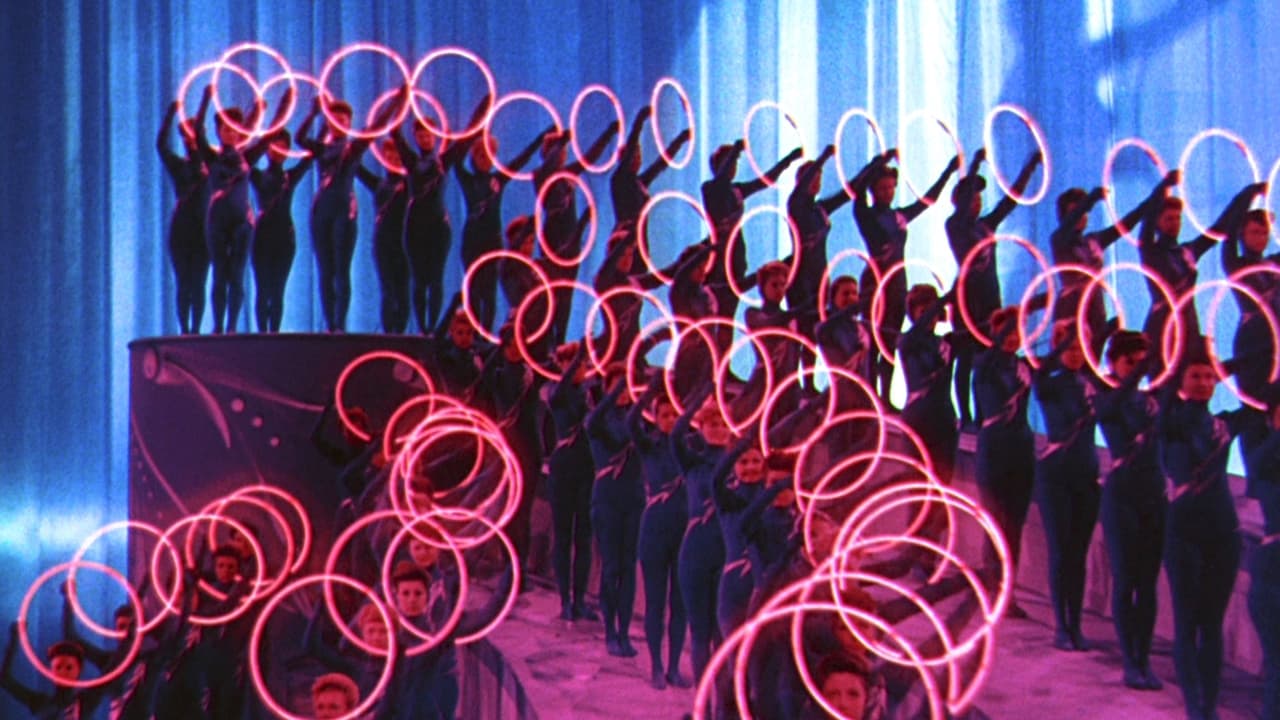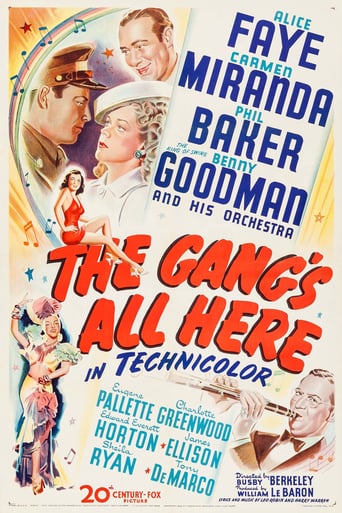

recommended
... View MoreThis movie feels like it was made purely to piss off people who want good shows
... View MoreMostly, the movie is committed to the value of a good time.
... View MoreThe movie is wonderful and true, an act of love in all its contradictions and complexity
... View MoreIf you're a fan of classic Hollywood films then now is one of the best times to be alive. Many of those classics are finding their way onto blu-ray via companies like Kino Lorber, The Film Detective, Olive Films and Twilight Time. And if you're a fan of movie musicals then this latest from Twilight Time should put a smile on your face. While not the most famous or the best thing from director Busby Berkeley there is plenty to enjoy here.The story is incredibly simple and for today's audiences far-fetched and yet it works. Andy Mason (James Ellison) is the son of a hot shot business man Andrew Mason (Eugene Palette) who has enlisted in the military and about to ship out. One night he finds his father and his father's best friend/partner Peyton Potter (Edward Everett Horton) at a New York nightclub filled with music and dance hall girls. The star of the show is Dorita (Carmen Miranda) but it is another singer who catches Andy's eye, Edie Allen (Alice Faye).Following her from the nightclub to a dime a dance club where she spends time with military men before they ship out he tries to pick her up. But that's not what she's there for, she's just interested in moral support. He eventually talks her into spending some time with him, gives her a false name of Casey and the two fall in love before he leaves.Fast forward to Andy's return home after becoming a hero in the Pacific. As he gets ready to visit his father at home Andrew plans a huge party for him, complete with a show put on by Phil Baker, the man who ran the nightclub we saw at the beginning of the film now in search of a rehearsal location. The plan is to use Peyton's home which should hold everyone much to his consternation. Also in attendance will be Peyton's wife (Charlotte Greenwood), who has a hidden past performing with Baker and their daughter Vivian (Shelia Ryan), the girl both families plan to marry to Andy.Who is the new star of this show? Why Edie of course who becomes fast friends with Vivian as they both talk about their guy in the way, one named Andy and one name Casey. What will happen when they eventually discover he is one in the same? The laughs are supplied by Miranda at her riotous best, Horton who plays the fussbudget of the bunch, Palette who is all bluster as usual and the situations the characters find themselves in. Greenwood nearly steals the show as the ex-showgirl turned society matron, more inclined to follow her past than present. Filled with a number of musical numbers, Benny Goodman and his band, solo performances and dancing galore the movie is a prime example of the classic musical comedy found just as the genre was coming into its heyday in the fifties.Berkeley was known for his musicals and the style with which he shot them. His famous kaleidoscopic used of cameras and dancing girls is on display here in seemingly effortless fashion. Much has been said about the subtle use of giant bananas in one segment but to watch it you never really consider the Freudian implications of it all. Instead you marvel at the images on screen and just enjoy the combination of music, dance and cinematography that combine to offer a treat.It's sad to note that this was Berkeley's only color film done with his famous style of choreography combined with camera work that made him a household name. But fortunately we do have this on hand to enjoy. I didn't find it to be one of his best works nor one of the greatest musicals I've watched but it was pure entertainment from start to finish. As is always the case Twilight Time offers a presentation that is second to none. As well as the movie itself we get an isolated score track, audio commentary with film historian Drew Casper, audio commentary with film historians Glenn Kenny, Ed Hulse and Farran Smith Nehme, a documentary on Busby Berkeley, Alice Faye's last film (a short she made), a deleted scene and the original theatrical trailer. Old time movie fans will want to add this one to their collection as will Busby Berkeley fans.
... View MoreI'll get to the plot of Busby Berkeley's "The Gang's All Here" in a minute, because the plot isn't the most memorable part of this movie. The most memorable part is the bananas.About 20 minutes into the movie, a towering hat of Technicolor fruit appears on the screen, followed by its owner--'40s "Brazilian bombshell" Carmen Miranda. She proceeds to do a number called "The Lady in the Tutti-Frutti Hat," accompanied by chorus girls who bear bananas. Six-foot-tall bananas that continuously droop and sprout until number's end, when the chorus girls, worn out by the burden of this mutated fruit, lay down for a long siesta on a stage dressed up like an island.There's a reason this number occurs so early on: It takes you the rest of the movie to convince yourself you actually saw this in a 1943 movie.But then, this is from Busby Berkeley, a director who staged his musical numbers as though he was declaring war. And next to kitsch, war is pretty much the motivator here.The wafer-thin story involves Andy (James Ellison), a soldier who woos and wins Edie (Alice Faye), a canteen dancer, the night before Andy goes off to World War Two. In what seems an instant, Andy gets decorated and returned home to a victory party thrown by the family of Andy's childhood sweetheart and fiancée--who, unfortunately for Edie, is not Edie.Will the heartbreak be resolved? Do you really care? The plot is mostly an excuse for some snappy repartee between major '40s stars (in particular, Eugene Palette and Edward Everett Horton are hilarious), and the kind of musical numbers that seem to drop out of thin air. (In a couple of scenes, Benny Goodman and his orchestra stroll by and do some songs just for the heck of it.) "The Gang's All Here" is really a 1943 time capsule, but an eye-popping rouser of one. They don't make 'em like this anymore. They didn't make 'em much like this back then, either.
... View MoreDirector and choreographer Busby Berkeley is in his element and is at his best with a new star, Miss Carmen Miranda! Carmen Miranda? You don't know her! Well, after this you will. A petite lady with a larger-than-life persona who can dazzle you with her spirit and stage presence. Alice Faye gets top billing and this movie can be found on a Alice Faye DVD collection as well as Carmen's DVD set, but Miss Miranda stops the show cold with some of her best showcases put on screen: the banana song and the trutti-frutti hat. Another highlight is Faye's polka-dot number, which closes the movie, another eye-popping showcase courtesy of Busby.I can't help feeling they could have picked a more charismatic actor for the lead other than James Ellison, and there are few things I could nit-pick about, but this is a musical which does defy believability anyway. He and Alice's romance did seem a bit rushed and forced near the beginning. Costarring Eugene Palette, Charlotte Greenwood and Edward Everett Horton, this is one upbeat film that you shouldn't think about too much and just enjoy. Oh, yeah, what about the plot, who cares?
... View MoreThe only problem with The Gangs All Here is the plot. It keeps getting in the way of the production numbers. Busby Berkeley manages to shoehorn four major numbers in the just the first 30 minutes, and he doesn't let up much after that. These numbers include everything Busby Berkeley could think of, from Benny Goodman swinging "Minnie's in the Money" to Alice Faye singing "No Love, No Nothing'" to some bizarre extravaganzas featuring lots of thighs, bananas and Carmen Miranda. You'll want to hit the fast forward button at regular intervals to get past the dull parts between them. The story is corny, the romantic misunderstanding is...yawn... and the acting is often weak (James Ellison as the male lead) or prissily unfunny (Edward Everett Horton). Still, the Technicolor is as garish as you could want and the songs by Harry Warren and Leo Robin work well. There's little time to think of anything except the numbers and what Berkeley does with them. Says a commentator in one of the DVD's extras, "He was a dance director who couldn't dance. In a Berkeley production it was the camera that danced." I'm not sure anyone could watch "The Lady with the Tutti Frutti Hat" and not be in awe of how Berkeley not only made use of all those chorines with the giant fruit, but how he kept the action going using his camera in intricately plotted movement. If you watch the Tutti Frutti number a second time, see how many of the chorus dancers you can spot with grim determination, not smiles, on their faces as they lug those giant bananas around and struggle to hit their marks while the camera swoops and turns. The story? Alice Faye is a showgirl. James Ellison is a soldier, the son of a wealthy family soon off to the Pacific. They fall for each other, but he has a sort of girl friend. His parents and the girl's parents think they should get hitched. Will Alice and Jim work things out? They do after approximately 100 minutes. Among the relatives and friends are Carmen Miranda, Eugene Palette, Charlotte Greenwood and Horton, There are a number of reasons to watch this movie, especially if you're interested in Busby Berkeley. It turned out to be his swan song as a major force in the movies. For me, the production numbers are a lot of fun, but the best reason is that classic song by Warren and Robin that Alice Faye introduced... No love, no nothing' / Until my baby comes home. No fun with no one, / As long as baby must roam. I promised him I'd wait for him /Till even Hades froze. I'm lonesome, heaven knows, / But what I said still goes. This became one of America's great songs of longing during WWII. If you want to hear more of them, you can't do better than Jo Stafford and her CD, G.I. Jo - Songs of World War II.
... View More